For two solid months (July 9th through September 8th) we enjoyed 1-4 Monarchs daily in our 47-year-old wildlife garden, many days including a female (or two) laying eggs. We saw our 1st Monarch on May 26th, then another on July 1st. On July 9th we spotted a female laying eggs, and the rest is history.
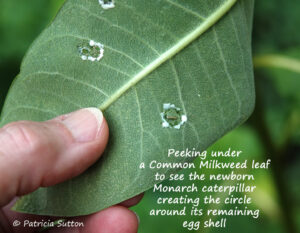 Our neighborhood may be more of a Monarch oasis than many neighborhoods because our wildlife garden harbors so many milkweed plants (over 100) and because I have milkweed scattered around our half acre, not all in one or two spots, and because we have a few nearby wildlife gardening neighbors with loads of milkweed . Garden strolls this summer and early fall included finding multiple eggs, tiny newly-hatched caterpillars, and large caterpillars. Even now, as I write this on September 18th, I am still finding multiple caterpillars (some small and some about to pupate). We have not found a chrysalis . . . YET, but that doesn’t keep us from looking.
Our neighborhood may be more of a Monarch oasis than many neighborhoods because our wildlife garden harbors so many milkweed plants (over 100) and because I have milkweed scattered around our half acre, not all in one or two spots, and because we have a few nearby wildlife gardening neighbors with loads of milkweed . Garden strolls this summer and early fall included finding multiple eggs, tiny newly-hatched caterpillars, and large caterpillars. Even now, as I write this on September 18th, I am still finding multiple caterpillars (some small and some about to pupate). We have not found a chrysalis . . . YET, but that doesn’t keep us from looking.
Our milkweed offerings are plentiful, including:
Butterfly Weed Several plants return each spring, but are not that happy in our richer-than-they-would-like soil. This native milkweed much prefers sand, gravel, bone-dry sites, and railroad beds, hence it’s other common name, Railroad Annie.
Eastern Swamp Milkweed Seven plants return each spring in my rain gardens, where hose ends empty out our rain barrels. This native milkweed is stunning and a magnet to all pollinators. By September, their leaves are pretty much dried up and not looking their best, but I leave all in place for wildlife!
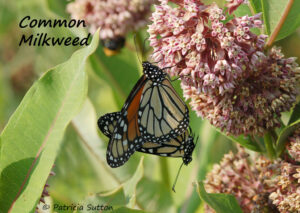 Common Milkweed Over one hundred plants are scattered throughout the sunny (and not so sunny) perennial garden, meadow, and vegetable garden. Many consider this milkweed to be a thug because it sends underground runners and pops up in entirely new sites like garden paths, lawn areas, other garden beds. For years I dug up these wayward milkweeds and substantial portions of their roots so I could give them away. Now I cherish each outlier because these outliers are less likely to attract as many predators. Monarch eggs and caterpillars on outliers seem to have a better chance of surviving. This native milkweed is a hotbed of Monarch activity. It blooms in late June / early July. Its fragrance is intoxicating and its huge pale pink balls of flowers steal the show and draw in many, many pollinators. By August and into October (and sometimes even through November), its leaves are still robust and being used by resident Monarchs as they lay one last batch of eggs before dying. These late-season eggs, if frosts hold off, result in one last generation of migratory Monarchs on the Cape May Peninsula (where the warm waters of the Atlantic Ocean and the Delaware Bay sustain micro habitats of pleasant weather).
Common Milkweed Over one hundred plants are scattered throughout the sunny (and not so sunny) perennial garden, meadow, and vegetable garden. Many consider this milkweed to be a thug because it sends underground runners and pops up in entirely new sites like garden paths, lawn areas, other garden beds. For years I dug up these wayward milkweeds and substantial portions of their roots so I could give them away. Now I cherish each outlier because these outliers are less likely to attract as many predators. Monarch eggs and caterpillars on outliers seem to have a better chance of surviving. This native milkweed is a hotbed of Monarch activity. It blooms in late June / early July. Its fragrance is intoxicating and its huge pale pink balls of flowers steal the show and draw in many, many pollinators. By August and into October (and sometimes even through November), its leaves are still robust and being used by resident Monarchs as they lay one last batch of eggs before dying. These late-season eggs, if frosts hold off, result in one last generation of migratory Monarchs on the Cape May Peninsula (where the warm waters of the Atlantic Ocean and the Delaware Bay sustain micro habitats of pleasant weather).
 Tropical Milkweed Each spring I purchase 4-5 plants at nearby Goshen Gardens nursery. I tuck this non-native annual milkweed into a few spots in my yard, including out front where I have no other milkweeds. Being an annual this milkweed blooms and blooms and continues to bloom right up until the first frost. It is a favorite of Monarchs for nectaring and egg-laying. September 7th I set up a study station for two young home-schooled naturalists. They discovered an egg and multiple caterpillars on two plants.
Tropical Milkweed Each spring I purchase 4-5 plants at nearby Goshen Gardens nursery. I tuck this non-native annual milkweed into a few spots in my yard, including out front where I have no other milkweeds. Being an annual this milkweed blooms and blooms and continues to bloom right up until the first frost. It is a favorite of Monarchs for nectaring and egg-laying. September 7th I set up a study station for two young home-schooled naturalists. They discovered an egg and multiple caterpillars on two plants.
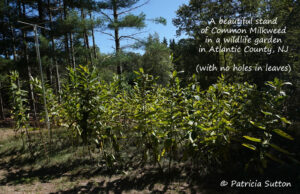 I had hoped that my own garden was an indicator that it was a good Monarch year. But I was in several milkweed-rich gardens on September 8, 2024. These gardens (in Atlantic County and Gloucester County) were part of a tour of Native Landscapes in South Jersey, organized by the SE Chapter of the Native Plant Society of NJ. The tour and the properties were inspirational. Each site was unique and offered great learning opportunities. But, I saw zero holes in milkweed leaves in the prolific patches. Huh! It was a shock to see so much untouched milkweed (without holes in the leaves). The garden owners shared that they had seen very few Monarchs so far this year.
I had hoped that my own garden was an indicator that it was a good Monarch year. But I was in several milkweed-rich gardens on September 8, 2024. These gardens (in Atlantic County and Gloucester County) were part of a tour of Native Landscapes in South Jersey, organized by the SE Chapter of the Native Plant Society of NJ. The tour and the properties were inspirational. Each site was unique and offered great learning opportunities. But, I saw zero holes in milkweed leaves in the prolific patches. Huh! It was a shock to see so much untouched milkweed (without holes in the leaves). The garden owners shared that they had seen very few Monarchs so far this year.
 In comparison, my milkweed leaves are full of holes! You might not realize this, but when the tiny Monarch caterpillar hatches from its egg, its first meal is what remains of its egg shell. Then it cuts through the leaf in a nice neat circle around the egg to get the milkweed milky sap (known as latex) to flow . The bit of leaf in the center of this circle is now latex free and safe for the tiny newborn Monarch caterpillar to eat . Elizabeth Howard / Journey North has a beautifully written and illustrated graphic on this topic: “Let’s Find Monarchs! Clues in the Milkweed Patch.”
In comparison, my milkweed leaves are full of holes! You might not realize this, but when the tiny Monarch caterpillar hatches from its egg, its first meal is what remains of its egg shell. Then it cuts through the leaf in a nice neat circle around the egg to get the milkweed milky sap (known as latex) to flow . The bit of leaf in the center of this circle is now latex free and safe for the tiny newborn Monarch caterpillar to eat . Elizabeth Howard / Journey North has a beautifully written and illustrated graphic on this topic: “Let’s Find Monarchs! Clues in the Milkweed Patch.”
Maybe the key to more Monarchs is having a few nearby neighbors who are also wildlife gardeners, so your own offerings are not the only show in town. And if you do have milkweed, be sure to have lots of it and scatter it around so that predators can not find every last egg and caterpillar. Predators are drawn to our wildlife gardens and all the life we’ve attracted. Predators are hungry too and a Monarch caterpillar is a choice meal for a paper wasp to carry back to its nest.
 Time will tell if summer Monarch numbers were good. They were in my garden; I still had 7 full grown caterpillars yesterday (September 17th), and that was without even peeking under all the leaves. But, as I learned just recently, even a county or two away they were absent.
Time will tell if summer Monarch numbers were good. They were in my garden; I still had 7 full grown caterpillars yesterday (September 17th), and that was without even peeking under all the leaves. But, as I learned just recently, even a county or two away they were absent.
This Fall’s Monarch Migration
If you are keen to witness this fall’s Monarch migration at Cape May, respond to cold fronts. When temperatures drop and you need to find your flannel PJs or a comforter, seriously consider making the journey to Cape May the next day. These cool winds from the north and northwest blow southbound migrating birds (and butterflies) out to the coast. Once migrants reach the coast they hug the land and follow it south (sometimes working hard not to be carried out over the treacherous Atlantic Ocean waters). These migrants reach lands end at Cape May Point.
Winds That Bring Monarchs to the Tip of the Cape May Peninsula
Often, the strong winds that carry migrating Monarchs to the tip of the Cape May Peninsula are winds that are not  conducive for crossing the Delaware Bay (strong winds that could blow them out to sea instead). Their numbers may build as they wait for gentler and more favorable winds to cross the bay. During these periods you can find them nectaring on Giant Sunflower and Groundsel-tree (Baccharis halimifolia) along the trails at the Cape May Point State Park and on Seaside Goldenrod in the dunes.
conducive for crossing the Delaware Bay (strong winds that could blow them out to sea instead). Their numbers may build as they wait for gentler and more favorable winds to cross the bay. During these periods you can find them nectaring on Giant Sunflower and Groundsel-tree (Baccharis halimifolia) along the trails at the Cape May Point State Park and on Seaside Goldenrod in the dunes.
Winds That Help Monarchs Cross the Delaware Bay
These gathering Monarchs wait for gentle tail winds (winds from the north or northeast) that will enable them to safely cross the Delaware Bay. Such winds often occur several days after a cold front has passed. In the meantime, while they are gathered at the tip, enjoy evening roosts (sometimes holding hundreds or thousands) and return at first light to watch “lift off” as they use these gentle tail winds to continue their migration.
There are many opportunities to learn about Monarchs:
NJ Audubon’s Calendar filters for all their Monarch events:
- Monarch Monitoring Project Drop In(s) at the Nature Center of Cape May
- Monarch Monitoring Project Drop In(s) at Triangle Park (in Cape May Point)
- Monarch Tagging Demos
The Cape May Point Science Center is also offering Monarch Butterfly Tagging Demonstrations using a solar-powered GPS device as part of their Project Monarch. These demonstrations will occur on Thursdays (September 19 and September 26) at 1:00 p.m. and on Saturdays (September 21 and September 28) at 11:30 a.m. Follow the Cape May Point Science Center’s Facebook page so you don’t miss these and other great learning opportunities.
Do not miss the September 29th Monarch Festival at the Nature Center of Cape May.
On Facebook, follow Cape May Monarchs – this page occasionally informs about Monarch migration, roosts, etc.
The Monarch Monitoring Project home page shares a lot of the history of this project.
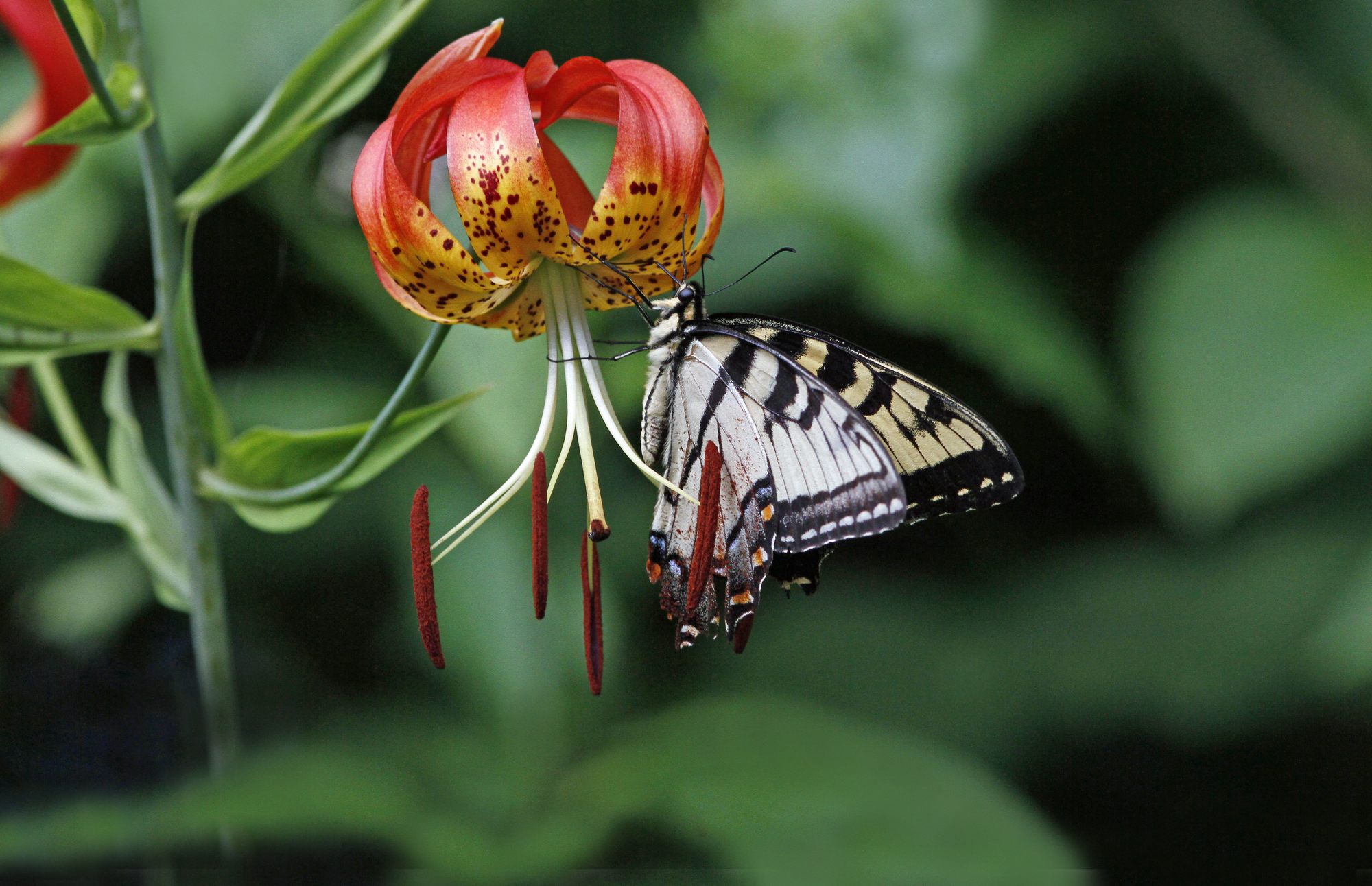
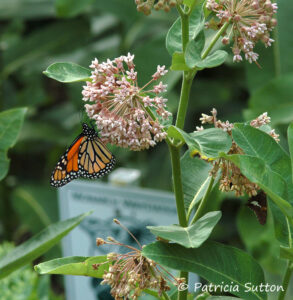
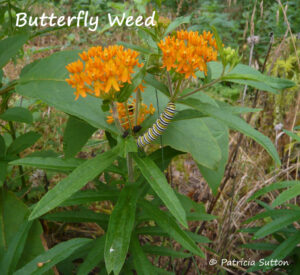


Pat, same thing for me on Stone Harbor Blvd. I have about 10 butterfly weed plants in my tiny sandy strip of a garden, about 4×12’
Mixed in are coreopsis, asters, blazing star and some goldenrod.
For the last 4 yrs I’ve seen at least a dozen caterpillars each summer and my leaves would be stripped by now. This year, I saw one and two days later it was gone and not many leaves eaten. I thought it was just bad luck for me this year, very sorry to see the same during the garden tour.
Hi Lynn, thank you for offering your oasis along Stone Harbor Boulevard. May this be an “off” year for you and may Monarchs return to your Butterfly Weed in future years and benefit from it. Thank you for sharing, Pat
Hi,
I live in Brick, which is in Ocean County. I have loads of common milkweed and have not seen one caterpillar. I also have purple milkweed and have seen one caterpillar. My yard is full of native plants but my neighbors’ yards are mostly lawns. Not sure what happened this year?
Laura
Hi Laura, thank you for sharing your story from Brick in Ocean County, NJ. I am fearful of the many private companies that offer to rid yards of all pests (mosquitoes, ticks, etc.). Their products “do in” butterflies and moths too; they won’t share that, but it is very true. I’ve certainly seen more and more of these private companies in my area and can not help but wonder about the toll they are taking. Thank you for gardening with native plants and offering “loads of Common Milkweed.” That is monumental! Certainly if Monarchs can make it to your oasis, they will survive!
Hi Pat,
Thank you so much for your forever font of wildlife and nature information. It has many times helped me with my gardening skills and appreciation of nature.
As you, I had many offshoots of my milkweed plants. I gave some away and some I just got rid of. In the future, I will transplant some to other areas in my garden.
Currently, the leaves of my 25+ milkweed stand look old, tough and droopy, even though I watered them constantly during this hot and dry summer.
This year, I only saw one Monarch Butterfly flitting about my 25+ milkweed plants, most likely laying eggs. Till this day, I have seen no Monarch caterpillar holes, nor any caterpillars.
I was told that Monarchs (and other insects) prefer young, soft leaves. Would it had been best for me to cut my milkweed plants in early growth in the spring, just as you have taught us to trim our asters?
Hi David,
Cutting back Common Milkweed can be tricky. Some do it with great success. Because I’ve not had much success, I cut back only a few plants and if they send up new growth, I am thrilled. If they don’t, I still have most of my stand that I did not cut back. Monarchs have laid their eggs on every last leaf in my wildlife garden, including young tender leaves and old gnarly leaves. So, just know that you are offering a wealth of food for egg-laying Monarchs if they should find your garden. Yes, having it in a number of locations is key because so many predators target caterpillars (and eggs), so every Monarch that makes it to adulthood is a miracle in my book!
Writing you from Egg Harbor Township. I have several different types of milkweed and many native plants including Common Milkweed, Butterfly weed, Eastern Swamp and a few others. Only saw 2 Monarchs this year, with only 1 full grown catepillar. Most years, my leaves are eaten entirely, this year, definately not the case. Very disappointing turnout of all butterflies this year.
Hi Lin, you are not alone in noticing fewer butterflies. Their decline and the decline of many, many insects world wide is a real concern and happening. You might want to read “The Insect Crisis: The Fall of the Tiny Empires That Run the World,” by Oliver Milman (2022). A friend gifted this book to me and it sent me spiraling into a deep depression (so be warned). You and I can seek refuge in our air-conditioned homes. Insects (and so much other life) do not have artificial refuges to escape into and they are struggling to survive in our new normal, climates with extremes, lengthy heat domes, etc. Climate change is taking a severe toll on insects and many of us are seeing it in our wildlife gardens with scary low numbers of butterflies where they were once abundant. We’ve got to keep providing these habitats for them (native plant gardens, meadows, and woods full of nectar spring through fall and abundant host plants), but there are far fewer (both in numbers and diversity) butterflies visiting our oases. Thank you so much for sharing! Pat
Pat
I am curious about what “giant sunflower” you are referring to?
“During these periods you can find them nectaring on Giant Sunflower and Groundsel-tree ”
Thanks
Hi James, Giant Sunflower (or Tall Sunflower), Helianthus giganteus, is our common sunflower in Cape May Point along the trails at the Cape May Point State Park. I’ve had it in my wildlife garden since 2007. I’ve shared divisions with fellow wildlife gardeners for years. Giant Sunflower definitely needs “haircuts,” otherwise by the time it blooms in September, it is so tall and top heavy with flowers that it can flop over. I have planted it in my primary Common Milkweed bed and that has been a very fun combination. The Common Milkweed blooms in late June/early July and then can be a bit unsightly by the fall (but still very important to Monarchs and other wildlife). By September the Giant Sunflowers bloom lushly and give that garden bed a whole other life of its own. Pollinators are all over it: Monarchs and other butterflies, many different bumble bees, etc!
Thank you! A search of “giant sunflower” certainly did NOT return Helianthus giganteus, as you can well imagine. 😉
Hi Pat,
My milkweed does have a lot of holes but I noted eggs only on a few and no caterpillars. I saw 2 monarchs this season.
A couple years ago I had so many caterpillars I had to find other resources of milkweed as they ate all I had.
Hi Ellen, There are so many predators that take a toll on Monarchs in all stages of their life, that I marvel at each and every adult Monarch that makes it to adulthood. I’ve seen many predators “do in” Monarch caterpillars: Spined Soldier Bugs (here’s my iNaturalist photo of one sucking dry a Monarch caterpillar in my garden: https://www.inaturalist.org/observations/105412627 ), Paper Wasps (here’s my iNaturalist photo of a paper wasp with a Monarch caterpillar: https://www.inaturalist.org/observations/242686483 ), Tachinid Flies lay their eggs on Monarch caterpillars, and Doug Tallamy recently shared with me that one of his graduate students monitored Monarch caterpillars and eggs (something I’ve always wanted to do, but I’ve always been pulled away by a garden task) and found that ants preyed on many, many eggs and caterpillars! It is a Jungle Out There!!! I have a program on just this topic that I am sharing on October 21st at the next meeting of the SE Chapter of the Native PLant Society of NJ. Hopefully some of your holes represent successful Monarch caterpillars that survived all the predators and successfully became adult Monarchs to further swell the summer population!
Pat thanks for the informative article and all your good work!
Here’s a 2024 summary from 2 neighbors in Sea Isle. We have 7 milkweed stands (and fennel for BSTs) between our gardens. Our milkweed are distanced approx 15 to 75 feet from the next. We think it’s been a decent season ( not best, not worst) for butterfly activity for monarchs (and black swallowtails who like our tender fennel plants).
Monarch sightings: began in July and they continue – approx 2-4 /day bouncing between our gardens. Hoping we get some migrating visitors over next week or 2.
Black swallowtails (bst) sightings: since late May/June (aided by 16 that overwintered and launched) and 2-4 continue to visit daily.
Note: it could be possible that most of our sighting activity is due to our rescue/raise/launch efforts.
2024 Rescued/hatched /raised counts summary:
Monarchs: 59 released
BST: 188 released
These #s are increased from last year.
2023 -24 Overwintered stats:
BST 28 chrysalis indoors : 15 launched in spring
Monarch 4 -none launched
Some observations:
1. During late July/August, 2-3 launches ( monarchs & bst) occurred daily. Since Labor Day, rate of emergence has slowed to 1 every 2-3 days. Perhaps cooler weather impact? They are wind protected but in shade – should we move to sunny location?
2. We see milkweed holes and are pretty vigilant looking for instars but it is rare to find the instar on the plant. Note: there is ALOT of other insect activity – aphids, flies, wasps on the plants so we have assumed that the predators get to them before we can rescue egg or instar. Is that a correct assumption? That’s why we rescue the eggs/instar to give them a chance ( see #s above)
3. Today (9/19) was an unusual day …we rescued 4 mid stage instars on balloon milkweed which is a standalone plant. Perhaps our common milkweed located 15 feet away is a distraction for would be predators ! But this am just before rescue, I did find a wasp circling the plant. We hope there is still time for them to get to chrysalis stage & launch this season. Thoughts on this late date?
What my milkweed had this year was oleander aphids by the thousands. They excreted so much honeydew that the milkweed leaves all got a black fungus and withered up. The plants still produced seeds but the leaves certainly didn’t look too appetizing for the poor caterpillars. Do you know of any way to deal with the aphids without hurting the caterpillars?
Hi Jill,
GREAT question about oleander aphids on your milkweed and concerns that they were so dense that their abundant honeydew resulted in a black fungus on your milkweed. By the time you wrote, late September, the damage was done. Sorry I never got back to this question in a timely fashion, but hopefully my answer will help you and others next spring and in future springs.
I’ll begin with the fact that oleander aphid are non-native; they are native to the Mediterranean and were introduced to North America. That being the case, I have no problem “doing in” their populations on my stands of milkweed (which has been planted for pollinators and for Monarchs). If not addressed when they first appear, an oleander aphid explosion could do in my milkweed patch as it did yours! I love our native aphids and have swooned at finding beech blight aphids and Harvester caterpillars hiding in their midst.
Each spring when I begin to notice oleander aphids on my milkweed leaves and stems, I squish them. At this time their numbers are small and so they are very easy to tackle and eliminate. Too, these sightings are so early in the spring that there is little chance of also damaging Monarch eggs and caterpillars, but I am always on the lookout for other life on my milkweed leaves as I squish the aphids and am careful not to “do in” other life.
By looking for and observing oleander aphids I have found some very fun creatures that prey on them and I have documented these creatures on my iNaturalist pages, including (1) Dusky-winged Hover Fly ( https://www.inaturalist.org/observations/104382830 ; https://www.inaturalist.org/observations/234402402 ; https://www.inaturalist.org/observations/232818317 ; https://www.inaturalist.org/observations/231944732 ), (2) Slender Smoothtail ( https://www.inaturalist.org/observations/169758112 ), and (3) Long-tailed Aphideater Complex ( https://www.inaturalist.org/observations/177598027 ) to name a few.
As I mentioned, when oleander aphids first appear, their numbers are small. So if you employ this simple approach, you should be able to keep them from multiplying at an alarming rate and causing problems like you saw in your garden in 2024. After an oleander aphid squishing session my fingertips are orange and need a good wash.